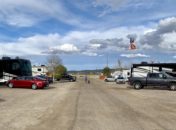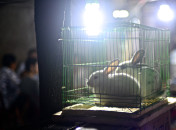We spent quite a bit of time debating whether to skip Venice in favor of somewhere less touristy. Surprising perhaps given the city’s rich history, sheer beauty and standing in the world of travel, but our preference for lower-key, natural settings and quality family time has become increasingly important on this adventure. Ultimately we decided to go, as it was a natural stop between Switzerland and Croatia, our next destination. It probably helped to go in with low expectations, but we are so glad we visited Venice.
We departed Haute-Nendaz early Saturday morning with hasty goodbyes to our friends. After buying tickets from Sion to Venezia Santa Lucia and grabbing a final breakfast of croissants and Lindt Chocolates (healthy), we boarded the first of four trains. Everything went well, even the short transfers.
Our only difficulty was at Milano Centrale Station where a woman standing at the train door asked to see my tickets. I was temporarily distracted but realized my mistake immediately – the woman had no association with the train line, and instead was working another great hustle. She showed us to our seats on the train and lifted our bags to the overhead storage, making a big production about how heavy they were. And then waited, staring at me. I’d been hustled for a tip – she expected five Euros for her time. “Heavy,” she said pointing at the bags. “Very heavy.” I didn’t want to give her anything, but forked over two euros and she huffed off angrily. The woman sitting next to us in the car fell victim to the same hustle but refused to pay up, and the angry “porter” took her bag down and put it in the middle of the aisle.
KNOW YOUR BOATS – THE VAPORETTO
The public transport system in Venice is quite good. Upon arrival we boarded a very crowed 5.1 waterbus (aka vaporetto).
After our Milan experience, I was watching closely for more hustles and in this case, a little help on and off the boat with luggage would have been worth a few Euros. The waterbus, as one might imagine, has no wheels other than the one to steer it. This wasn’t our first experience using a waterbus – we’d commuted along Bangkok’s Chao Phraya River in several – and this bus was packed almost as tight. After twenty minutes, we successfully identified our stop and headed to the hotel.
Our goal for Venice was simple – explore and get away from cruise ship throngs. We didn’t visit any museums, walked briskly through Piazza San Marco and cut through the crowds on the Rialto Bridge with purpose. Angela had timed our visit for October so that we could avoid the crowds and the heat, and she nailed it. Even though the tourist hot spots were teeming with people, it was one tenth what it would have been in July. And the weather was nice.
VENICE ON A SUNDAY
After breakfast on our first day, we strolled through the city with only a map and a few possible destinations. We wandered through the sestieri of Castello, San Marco, San Polo and Cannaregio. And we genuinely got lost – finding empty, narrow streets, and little alleys so quiet that we could hear conversations coming from inside the stone walls. In a tucked-away square, a large family sat at a long wooden table eating their post-Mass meal. The young boys, in white shirts with the sleeves rolled up and their ties flung over their shoulders, were kicking a soccer ball against the windowless side of a church. The parents, grandparents, uncles and aunts sipped coffee and smoked cigarettes under huge striped umbrellas. It’s surprisingly easy to escape the throngs and find real life in Venice, if you’re willing to get lost.
Venice consists of 118 submerged islands, over 400 footbridges and 170 boat canals. Although we walked quite a bit, we didn’t come even close to visiting them all – but we did manage to try out each of Venice’s public transport boats.
KNOW YOUR BOATS – THE TRAGHETTO
After wandering around the fish market we decided to cross the Grand Canal on one of the stand-up gondolas that ferry passengers one-way from point to point. For two Euros each (free for kids), they waited until they filled the boat, then paddled us across to the northern side. Easy. Even with heavy traffic it took less than two minutes to cross.
KNOW YOUR BOATS – THE GONDOLA
Gondolas, the distinct long black canoes with funny-looking steel hammers affixed to their bows, are the most famous boats in Venice. They are also serious business, with strict standards and fixed pricing regulated by a guild. And each year there is a huge competition among the gondoliers – the Regata Storica di Venezia.
Asher really (I mean REALLY) wanted to take a gondola ride. Despite the threat of rain, we hoofed it over to the Campo Santa Maria Formosa where we’d passed a group of gondoliers the day before, but they were gone. We headed deeper into the heart of the tourist areas – how hard could it be to find a gondolier, right? It’s like finding a taxi in New York! But we didn’t see any until the Rialto Bridge, where they descended like vultures, trying to get us on board before talking route or cost. Each offered only short trips up and down the choppy waters of the Grand Canal. Fed up, we wandered deeper into the San Polo setiere near Campo di San Cassiano. The threat of rain was growing and we were all tired after almost 90 minutes of searching for a damn gondola, so I asked a gelato vendor and she recommended a guy a few bridges away.
IGOR VIGNOTTO
We approached a gentleman just on the other side of a Rio de Santa Maria Mater Domini footbridge. He was quite tall and thin with a shaved head and a big smile. His English was excellent and he had an easy manner – he didn’t hard-sell us. We asked for a small canals tour and were off.
“My name is Igor,” he said. “It’s not very Italian, but my dad really liked the name.” He told us that his dad was a career gondolier, and so was his grandfather. His boat’s name was Aurora, after his daughter, but his son Santiago was too young to have yet decided whether a gondolier’s life is right for him. As we glided through the canals, he shared with us stories about the buildings, the history of Venice and the significance of the pole colors. He took us down several very quiet stretches and when he wasn’t sharing facts about Venice, he sang. It wasn’t for us, and it wasn’t for show. It was the kind of distracted singing you do when you’re driving through traffic – you know, kind of halfway committed to hitting the notes and nailing the lyrics. His voice was pleasant as it echoed off the stone walls and bridges.
Igor was a bit more of a big deal than he let on. At every bridge, he received a lot of greetings, waves and smiles from locals – people walking along with their groceries or heading off to work. He seemed to know everyone in town, or more importantly, everyone knew him. I asked if he was famous and he opened up. “I rowed for the Pope when he visited Venice,” he explained as he pulled up a photo on his phone. He told us that it was a big honor to have been chosen by his fellow gondoliers to row the Pope during his tour a few years back. He told us to Google him* if we wanted to see more pictures.
Igor was one of the best parts of our trip to Venice.
KNOW YOUR BOATS – THE WATER TAXI
Since we needed to catch our bus into Croatia from the Tronchetto parking lot on the other end of Venice, we booked a water taxi to save the hassle of multiple water bus connections. The boat was like a long Chris Craft with a covered top for protection in case of rain. It picked us up barely a block from the hotel and slipped out through the narrow canals to the lagoon. The 25 minute ride in the cool morning air gave us a long last look at Venice.
* We Googled Igor and discovered quite an interesting past. In addition to rowing the Pope – which didn’t make all gondoliers very happy due to some of his questionable antics – he has been champion of the Regata Storica di Venezia many times. It seems we got our tour of Venice from the Michael Jordan of gondoliers.
CLICK ANY PHOTO TO OPEN THE GALLERY.

















































